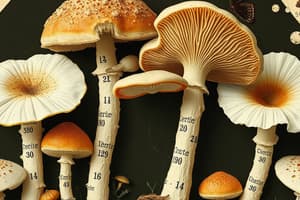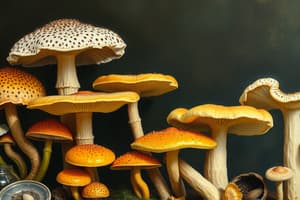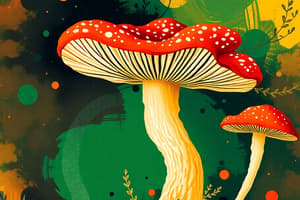Podcast
Questions and Answers
Which of the following statements about fungi is accurate?
Which of the following statements about fungi is accurate?
- Some fungi are obligate aerobes.
- Many fungi thrive in anaerobic environments.
- All fungi are non-motile. (correct)
- All fungi are capable of movement.
Which characteristic is true for the classification of fungi?
Which characteristic is true for the classification of fungi?
- Fungi are obligate anaerobes.
- Fungi lack the ability to move. (correct)
- Fungi can live in extreme high temperatures.
- All fungi can swim in water.
What is a correct statement regarding the respiratory categories of fungi?
What is a correct statement regarding the respiratory categories of fungi?
- Fungi can be classified into motile and non-motile groups.
- Fungi are predominantly obligate anaerobes.
- Fungi need oxygen to survive. (correct)
- Fungi can perform photosynthesis.
Which statement about the physical characteristics of fungi is incorrect?
Which statement about the physical characteristics of fungi is incorrect?
What best describes the mobility of fungi?
What best describes the mobility of fungi?
What is a common cause for subcutaneous mycoses?
What is a common cause for subcutaneous mycoses?
Which of the following tissues are primarily involved in subcutaneous mycoses?
Which of the following tissues are primarily involved in subcutaneous mycoses?
What is another name commonly associated with subcutaneous mycoses affecting the foot?
What is another name commonly associated with subcutaneous mycoses affecting the foot?
What type of infections do subcutaneous mycoses represent?
What type of infections do subcutaneous mycoses represent?
Where do the fungi that cause subcutaneous mycoses typically reside?
Where do the fungi that cause subcutaneous mycoses typically reside?
What do cutaneous mycoses primarily affect?
What do cutaneous mycoses primarily affect?
Which of the following is a type of cutaneous mycosis?
Which of the following is a type of cutaneous mycosis?
What is another term used for dermatophytosis?
What is another term used for dermatophytosis?
Which of the following is NOT a cause of cutaneous mycoses?
Which of the following is NOT a cause of cutaneous mycoses?
Cutaneous Candidiasis is caused by which type of organism?
Cutaneous Candidiasis is caused by which type of organism?
What method of reproduction do they utilize?
What method of reproduction do they utilize?
What are pseudohyphae best described as?
What are pseudohyphae best described as?
Which of the following terms describes the appearance of pseudohyphae?
Which of the following terms describes the appearance of pseudohyphae?
Which term does NOT apply to pseudohyphae?
Which term does NOT apply to pseudohyphae?
What characteristic distinguishes pseudohyphae from true hyphae?
What characteristic distinguishes pseudohyphae from true hyphae?
What is the primary characteristic of mycetoma infections?
What is the primary characteristic of mycetoma infections?
Which type of infections affect internal organs?
Which type of infections affect internal organs?
What treatment may be necessary for mycetoma infections?
What treatment may be necessary for mycetoma infections?
Which statement about systemic mycoses is false?
Which statement about systemic mycoses is false?
What is a common challenge associated with treating mycetoma?
What is a common challenge associated with treating mycetoma?
What is mycotoxicosis primarily caused by?
What is mycotoxicosis primarily caused by?
Which organ is NOT affected by mushroom poisoning?
Which organ is NOT affected by mushroom poisoning?
Which of the following describes a consequence of mycotoxicosis?
Which of the following describes a consequence of mycotoxicosis?
What type of food is most commonly associated with causing mycotoxicosis?
What type of food is most commonly associated with causing mycotoxicosis?
Which of the following is NOT a symptom of mushroom poisoning?
Which of the following is NOT a symptom of mushroom poisoning?
Flashcards
Obligate Anaerobes
Obligate Anaerobes
Organisms that cannot survive in the presence of oxygen.
Obligate Aerobes
Obligate Aerobes
Organisms that require oxygen to survive.
Facultative Anaerobes
Facultative Anaerobes
Organisms that can survive with or without oxygen.
Fungi are non-motile
Fungi are non-motile
Signup and view all the flashcards
All Fungi are Non-Motile
All Fungi are Non-Motile
Signup and view all the flashcards
Budding
Budding
Signup and view all the flashcards
Asexual Reproduction
Asexual Reproduction
Signup and view all the flashcards
Pseudohyphae
Pseudohyphae
Signup and view all the flashcards
Hyphae
Hyphae
Signup and view all the flashcards
Yeast
Yeast
Signup and view all the flashcards
Cutaneous Mycoses
Cutaneous Mycoses
Signup and view all the flashcards
Superficial Mycoses
Superficial Mycoses
Signup and view all the flashcards
Dermatophytosis
Dermatophytosis
Signup and view all the flashcards
Subcutaneous Mycoses
Subcutaneous Mycoses
Signup and view all the flashcards
Tinea
Tinea
Signup and view all the flashcards
Cutaneous Candidiasis
Cutaneous Candidiasis
Signup and view all the flashcards
Pulmonary Mycoses
Pulmonary Mycoses
Signup and view all the flashcards
Systemic Mycoses
Systemic Mycoses
Signup and view all the flashcards
Oral Candidiasis (Thrush)
Oral Candidiasis (Thrush)
Signup and view all the flashcards
Mycetoma
Mycetoma
Signup and view all the flashcards
How Subcutaneous Mycoses Start
How Subcutaneous Mycoses Start
Signup and view all the flashcards
Madura Foot
Madura Foot
Signup and view all the flashcards
Where Subcutaneous Mycosis Fungi Live
Where Subcutaneous Mycosis Fungi Live
Signup and view all the flashcards
How Madura Foot Develops
How Madura Foot Develops
Signup and view all the flashcards
Mycotoxicosis
Mycotoxicosis
Signup and view all the flashcards
Mushroom Poisoning
Mushroom Poisoning
Signup and view all the flashcards
Damage to liver, kidney and bone marrow due to mushroom poisoning
Damage to liver, kidney and bone marrow due to mushroom poisoning
Signup and view all the flashcards
Fungal toxins
Fungal toxins
Signup and view all the flashcards
Food contaminated with fungal toxins
Food contaminated with fungal toxins
Signup and view all the flashcards
Study Notes
General Mycology
- Mycology is the study of fungi.
- Medical mycology focuses on pathogenic fungi that cause disease.
Fungi vs. Bacteria
- Size: Fungi are larger than bacteria.
- Cell Type: Fungi are eukaryotic, bacteria are prokaryotic.
- Mitochondria: Fungi have mitochondria, bacteria don't.
- Sterols in cell membrane: Fungi contain ergosterol, the target of antifungal agents. Bacteria lack sterols in their cell membranes except those of the mycoplasma group. These have a sterol-like substance in their plasma membranes.
- Cell Wall Content: Fungal cell walls are made of chitin; this is target of action against anti-fungal agents. Bacterial cell walls contain peptidoglycan.
- Spores: Fungi reproduce via spores, bacteria don't (generally).
- Metabolism: All fungi are heterotrophs and aerobes, while some bacteria are also heterotrophs but some are anaerobic or facultative anaerobes.
Fungal Morphology
- Moulds (Filamentous Fungi):
- Multicellular filaments called hyphae
- Hyphae may be septate (cross-walls) or non-septate (no cross-walls).
- Grow by branching and tip elongation to form a mycelium
- Examples: Aspergillus, Penicillium, Dermatophytes
- Yeasts:
- Unicellular (single-celled), oval or round shapes
- Reproduce asexually by budding, and can form pseudohyphae (sausage-like chains).
- Examples: Candida, Cryptococcus
Clinical Classification of Fungal Infections
- Superficial mycoses: Affect the outermost keratinized layer of skin and appendages, e.g., tinea versicolor (hypopigmented/hyperpigmented areas).
- Cutaneous mycoses: Affect deeper layers of skin (e.g., dermatophytes causing various ringworm infections and cutaneous candidiasis).
- Subcutaneous mycoses: Chronic infections involving dermis, subcutaneous tissue, muscles, and fascia (e.g., Madura foot initiated by piercing trauma & mycetoma).
- Systemic mycoses: Affect internal organs. These may be:
- True pathogens infecting healthy individuals (e.g., Histoplasma, Blastomyces)
- Opportunistic pathogens infecting individuals with weakened immune systems or compromised immune responses(e.g., Cryptococcus, Candida)
- Some conditions that raise vulnerability to these opportunistic infections include diabetes, cancer, corticosteroid therapy, cytotoxic drugs, and prolonged antibiotic therapy.
Mycotoxicosis
- Caused by consuming food contaminated with fungal toxins.
- Examples: mushroom poisoning, aflatoxin from Aspergillus flavus (liver damage/cancer).
Allergic Disorders
- Fungal spores (e.g., Aspergillus) can act as allergens in some forms of atopy (e.g., asthma, hay fever).
Fungal Infection Diagnosis
- Direct methods: Detect fungi or their antigens in specimens or isolate the organism.
- Indirect methods: Detect antibodies against the suspected fungal infection in serum or via skin tests.
Antifungal Drugs
- Fungi are eukaryotes, so ideally, non-toxic, systemically active drugs are limited in their range (selectivity).
- Antifungal drugs target ergosterol, a component of fungal cell membranes.
- Contrastingly, bacterial cell membranes contain cholesterol.
- Common antifungal drugs include: Mycostatin (nystatin); azole drugs (e.g., fluconazole, ketoconazole).
Studying That Suits You
Use AI to generate personalized quizzes and flashcards to suit your learning preferences.




